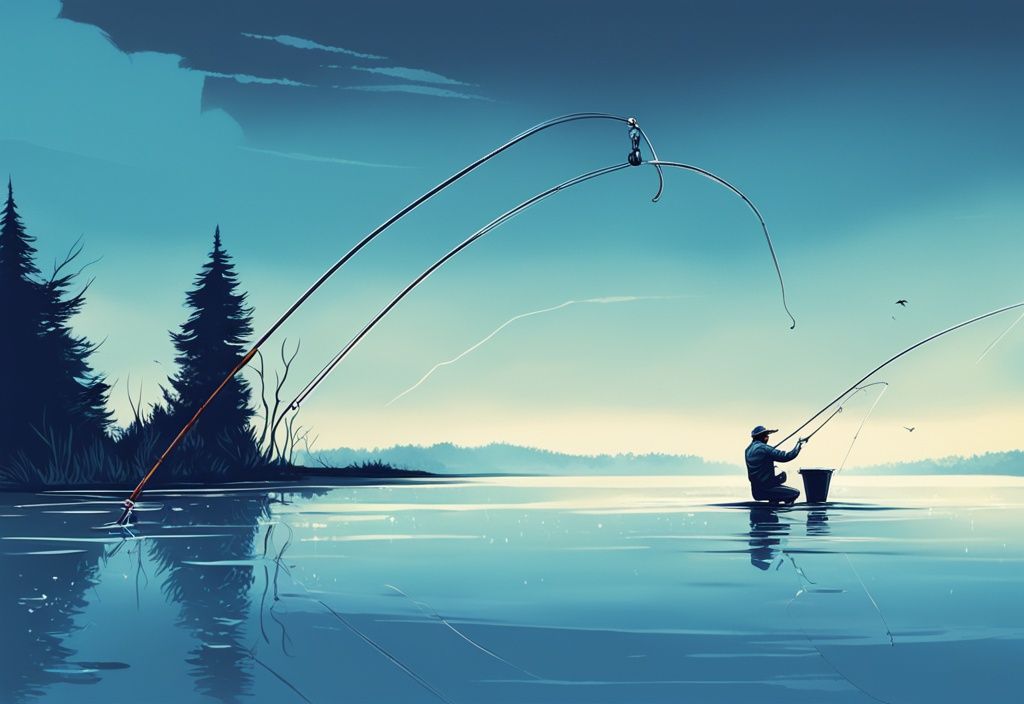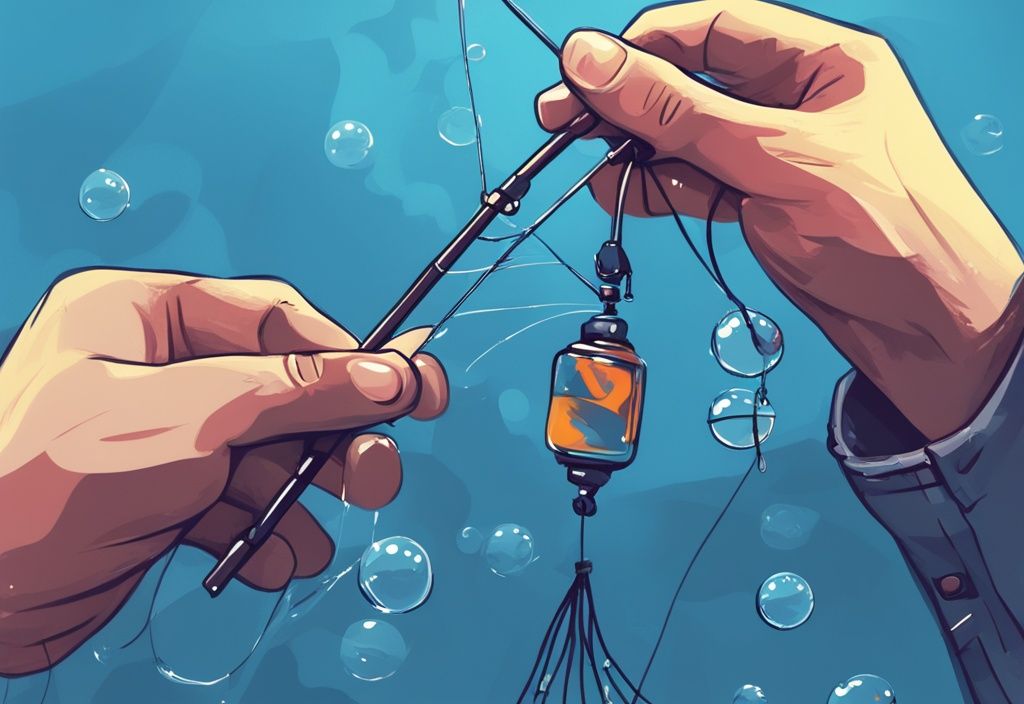Ah, the Chatterbait—a lure that’s as versatile as it is effective. I remember the first time I cast one into the water, the sun warming my back, and felt that unmistakable vibration through the line. Introduced in the early 2000s, this little marvel has become a staple in tackle boxes everywhere, thanks to its ability to mimic a frantic baitfish. But how do you truly unlock its potential? Understanding the nuances of fishing a Chatterbait can turn an average day on the water into a memorable one. Whether you’re a weekend warrior or a seasoned pro, this guide will help you choose the right Chatterbait, rig it perfectly, and master those all-important casting and retrieving techniques. Ready to up your game?
What is a Chatterbait?
Ah, the Chatterbait! This little marvel is a versatile fishing lure that cleverly marries the action of a spinnerbait with the silhouette of a jig. Picture it: a lure that dances through the water, mimicking prey with its signature vibrating action. That’s the magic of the Chatterbait. When you’re figuring out how to fish a Chatterbait, understanding these dynamic features is key. The vibration from the blade is like a dinner bell for fish, especially bass, making it a top pick for anglers like us.
What makes a Chatterbait so effective? It’s all about adaptability. Whether you’re casting just beneath the surface, weaving through grass, exploring shallow waters, or skimming along the bottom, this lure is your trusty sidekick. Its versatility is a game-changer, and that’s why many of us swear by it. Mastering how to fish a Chatterbait can truly elevate your fishing game and boost your chances of landing that trophy catch. So, why not give it a whirl and see the magic unfold?
Understanding the Anatomy of a Chatterbait
Picture this: you’re out on the water, the sun warming your back, and you’re armed with one of the most versatile lures in your tackle box—the Chatterbait. This little marvel is a blend of a spinnerbait and a jig, making it a must-have for any angler looking to up their game. At the heart of its magic is the bladed jig. The blade, strategically attached to the front, creates a unique vibration and movement in the water. This isn’t just any movement; it’s the kind that mimics the erratic dance of prey, stirring up the bass’s predatory instincts.
But wait, there’s more to this lure than just the blade. The skirt is the unsung hero, adding bulk and a splash of color that makes the Chatterbait irresistible. Imagine the visual allure as it skirts through the water, its colors perfectly matching the local forage. This is what we call “matching the hatch,” and it’s a game-changer for increasing your catch rate.
Now, when you’re figuring out how to fish a Chatterbait, understanding its anatomy is your first step to success. The dance between the blade and the skirt is what makes this lure a standout performer. Whether you’re fishing in crystal-clear waters or murky depths, the Chatterbait adapts beautifully. Mastering this lure can seriously boost your fishing success, especially if you’re after bass. So, are you ready to feel that tug on your line?
Why Chatterbaits are Effective for Fishing
Chatterbaits have become a staple in my tackle box, and for good reason. These versatile lures shine in a variety of fishing conditions, adapting to both fast and slow retrieves. Imagine casting into open water, feeling the sun warming your shoulders, or threading your way through dense cover. Chatterbaits excel across different depths, making them a reliable choice no matter where your fishing adventures take you.
What makes these lures so effective? It’s all in the blade. The unique design creates a vibration that mimics the frantic movement of prey. This vibration is like a dinner bell for bass and other predatory fish, triggering their instinct to strike. The lure’s ability to imitate natural prey movements is a game-changer, upping your chances of landing that trophy catch.

But wait, there’s more! Chatterbaits are your best friend in murky waters where visibility is low. In these conditions, fish rely heavily on their lateral line senses rather than sight. The vibration and movement of the Chatterbait cut through the murk, drawing attention when other lures might go unnoticed. It’s like having a secret weapon in your tackle box for those challenging fishing spots.
Choosing the Right Chatterbait
When it comes to fishing with a Chatterbait, picking the right one can make all the difference. From size and color to matching the hatch with trailers, each choice plays a vital role in your success on the water.
How to Select the Correct Size and Color
Ah, the age-old question: what size and color should you use? Picture this: you’re out on the lake, the sun’s just peeking over the horizon, and you’re ready to cast. The right Chatterbait can be your best ally.
In murky waters, darker colors are your go-to. They create a silhouette that fish can spot, even in low visibility. Think about it—if you’re targeting bluegill, those darker hues can be your secret weapon. On the flip side, clear waters call for lighter colors. These mimic the natural look of baitfish, making them irresistible to your finned friends. And if you’re out there in early spring, don’t forget the red Chatterbaits. They look just like crawdads, a favorite snack for bass gearing up to spawn.
Matching the Hatch: Tips for Selecting Trailers
Now, let’s talk trailers. These little additions can transform your Chatterbait into a fish magnet. Imagine you’re in waters teeming with shad, trout, or minnows. Slender swimbait profiles are your best bet—they mirror these baitfish perfectly.
But what if the local menu consists of panfish? Go for fuller trailer profiles that mimic their bulkier shape. And if you’re all about that slow-rolling technique, crawfish-imitating trailers are the way to go. They replicate the natural movement of crawfish scuttling along the bottom, and trust me, bass can’t resist.
So, next time you’re gearing up for a fishing trip, remember these tips. With the right Chatterbait, you’re not just fishing—you’re setting the stage for an epic adventure.
How to Rig Your Chatterbait
Rigging a Chatterbait is an art that blends creativity with technique, ensuring you get the most out of this versatile lure. From selecting the right trailer to adjusting for different conditions, every choice can make a difference in your fishing success.

Enhancing Action with a Trailer
Adding a trailer to your Chatterbait? That’s like giving it a turbo boost! Most folks, including myself, lean towards soft plastic trailers like swimbaits or crawfish. Why? They mimic the natural movement of prey, making your lure irresistible. Imagine the rhythmic dance of a paddle tail swimbait in the water—it’s poetry in motion. If you’re in the mood for a steady retrieve, these are your go-to. But if you’re feeling adventurous and want to “burn” through the water, go for trailers with less action. They keep the speed up without losing effectiveness. Ever tried it? It’s a game-changer!
Adjusting Your Chatterbait for Different Fishing Conditions
Fishing a Chatterbait is like solving a puzzle. Each piece—speed, trailer, line—must fit the conditions. A fast reel is your best friend for quick retrieves, letting you cover water like a pro. Pair it with a braided line for that extra sensitivity and strength. Trust me, you’ll feel every vibration and strike.
Now, let’s talk about adapting. In clear water, a slow retrieve with a subtle trailer can be magic. But in murky waters? Crank up the speed and go for a vibrant trailer. It’s all about catching the fish’s eye. Adjusting your approach based on the environment isn’t just smart—it’s essential. And that’s what makes fishing so thrilling, right?
Mastering Chatterbait Casting and Retrieving Techniques
Casting and retrieving a Chatterbait isn’t just about throwing it out there and hoping for the best. It’s an art form that, when done right, can make your fishing trip unforgettable. Let’s dive into the basics and then explore some advanced methods to level up your game.
Learn the Basic Cast and Retrieve Method
There’s something almost meditative about casting a Chatterbait and letting it sink to the depths. This sinking phase is where the magic starts, positioning the lure right in the fish’s living room. Once it’s settled, reel it in with a steady rhythm. Imagine you’re a conductor, orchestrating the lure’s dance to mimic a tasty morsel of prey. Keep your rod tip down, feeling that satisfying vibration signaling the Chatterbait is doing its job. And when that vibration suddenly stops? Get ready! A swift upward hook set might just land you a catch worth bragging about.
Advanced Techniques: Burning, Slow Rolling, and More
Ready to take it up a notch? Let’s talk about burning and slow rolling. Burning is all about speed, cranking that reel to make the blade vibrate like a rock star. This technique shines over submerged grasses, where fish love to lurk. On the flip side, slow rolling is like a lazy Sunday drive, dragging the Chatterbait along the bottom to mimic baitfish or crawfish. It’s perfect for coaxing those bottom-dwelling fish into action. Throw in a few jerks for good measure, creating bursts of vibration that mimic a prey in distress. Mixing up your retrieve keeps the fish guessing and ups your chances of a strike.
Essential Tips for Successful Chatterbait Fishing
Chatterbait fishing is an art form that combines skill, patience, and a touch of intuition. Whether you’re a seasoned pro or a curious beginner, these tips will help you master the craft and reel in your next big catch.
Detecting and Setting the Hook
When you’re out there learning how to fish a Chatterbait, detecting a bite is like a secret handshake between you and the fish. Ever felt that sudden weight or a distinct tug on your line? That’s your cue! React quickly with a sharp upward jerk of the rod. This motion is your ticket to success, ensuring the hook penetrates just right. Chatterbait hooks are razor-sharp, so you don’t need to muscle it—just a quick flick will do. Keep those reflexes sharp, and you’ll be hooking your catch in no time!
Fighting the Fish: Keeping the Line Tight
Once you’ve got a fish on the line, the real fun begins. Keeping tension on the line is your golden rule. Imagine you’re dancing with the fish, keeping the rod tip up and letting the rod’s flexibility do the heavy lifting. It’s not about brute strength; it’s about finesse. This technique helps absorb the fish’s wild moves, reducing the risk of a snapped line. With practice and a pinch of patience, you’ll master this skill, ensuring you can handle the fish’s fight and bring it in like a pro.

Avoid These Common Chatterbait Fishing Mistakes
Let’s talk about some common missteps that can trip you up. One biggie is not matching the hatch. Picture this: you’re using the wrong size and color of the lure for the local baitfish. It’s like showing up to a party in the wrong outfit! Also, don’t underestimate the power of the right trailer. An inappropriate trailer can dull the lure’s magic. Remember, it’s all about adapting to water conditions and fish behavior. Adjust your techniques, and you’ll up your chances of a successful catch.
FAQ
What is the Best Time of Year to Fish with a Chatterbait?
Chatterbaits are a versatile tool in any angler’s tackle box, working wonders throughout the year. But let me tell you, they really shine in the fall. Picture this: fish are on the move, feeding with gusto as the water cools. And then there’s early spring, a magical time when bass are gearing up for the spawn. It’s like nature’s own fishing festival!
Can I Use a Chatterbait in Clear Water?
Absolutely, you can! In clear water, it’s all about finesse and matching the hatch. Go for those lighter colors, and tweak your retrieve to mimic the local baitfish. Think of it as a dance, where you’re leading and the fish are following. It’s a beautiful thing when it all comes together.
What Type of Rod and Reel Setup is Best for Chatterbait Fishing?
For the perfect Chatterbait setup, imagine a 7′ medium-heavy power casting rod with fast action. It’s like having the right tool for the job, giving you the control and power you need. Pair that with a braided line for those long, satisfying casts, and a lower gear ratio reel to keep the lure moving just right. It’s a combo that feels just right in your hands.
How Do I Choose the Right Trailer for My Chatterbait?
Choosing the right trailer is like picking the right dance partner. Consider the local forage and your fishing style. If shad or minnows are the main course, go for slender swimbait profiles. For panfish, a fuller profile does the trick. And if you’re slow rolling, a crawfish-imitating trailer can be your best friend. It’s all about matching the mood of the water.
Conclusion
Mastering the art of how to fish a Chatterbait is a journey full of rewards and surprises. Imagine standing by the water’s edge, feeling the cool breeze as you cast your line. The Chatterbait, with its unique blend of a bladed jig and a skirt, dances through the water, mimicking prey with its irresistible vibrating action. This is where the magic begins.
Understanding this lure’s anatomy is key. It’s like knowing the secret handshake to a club where only the fish are members. Choosing the right size and color is crucial, matching the lure to the baitfish your target species are feeding on. It’s a bit like picking the perfect outfit for a party—get it right, and you’re the star of the show.
Adapting your techniques to different conditions is where the real fun starts. Whether you’re casting in murky waters or crystal-clear lakes, tweaking your approach to suit the water clarity and fish behavior can make all the difference. Patience is your best friend here. Just like learning to ride a bike, mastering Chatterbait fishing takes time and practice. For those keen on measuring their catches accurately, it’s worth exploring the best 5 fishing scales to ensure precision and satisfaction in your fishing endeavors.
With the right setup—think of it as your fishing toolkit—you’re ready to take on any challenge. A suitable rod and reel, paired with strategic trailer selections and varied retrieve methods, can turn Chatterbaits into an indispensable part of your tackle box. Their versatility and effectiveness across diverse fishing scenarios make them a must-have for any angler looking to broaden their horizons.
So, next time you’re out there, remember, it’s not just about the catch. It’s about the thrill of the chase, the serenity of the surroundings, and the joy of the sport. Happy fishing!


